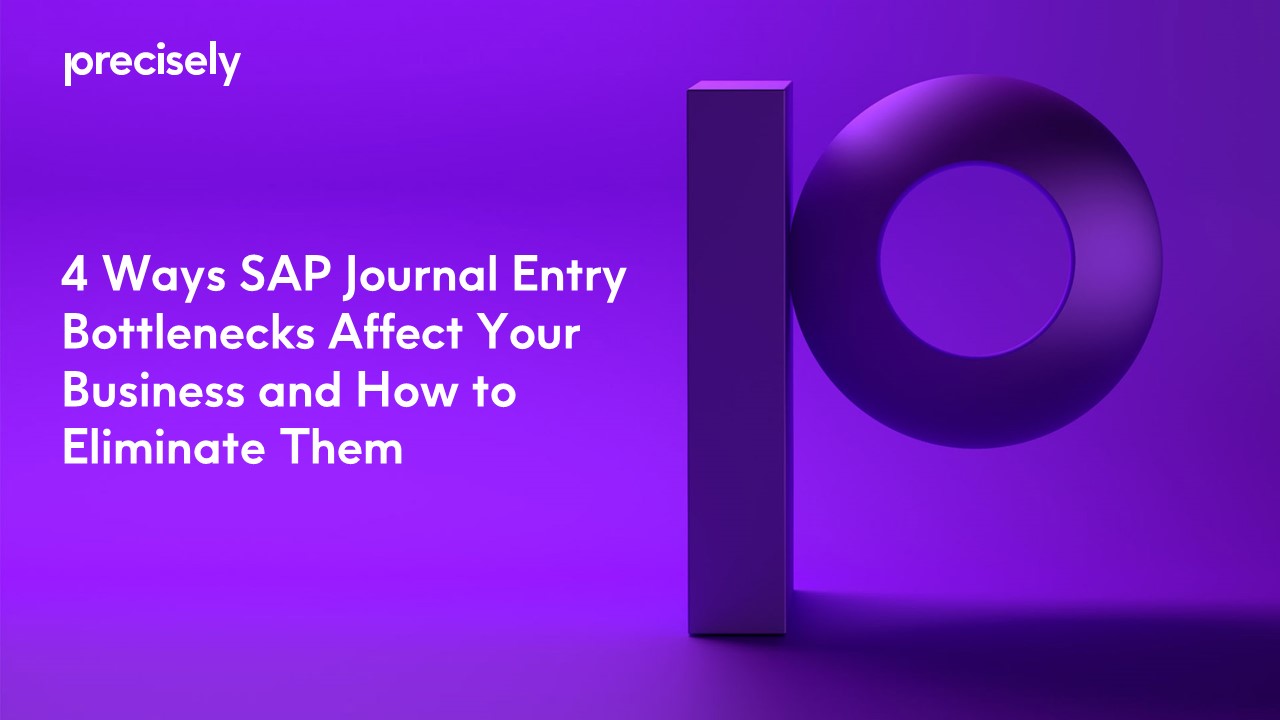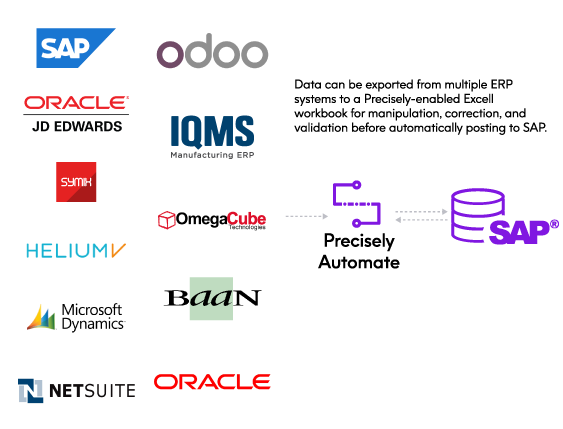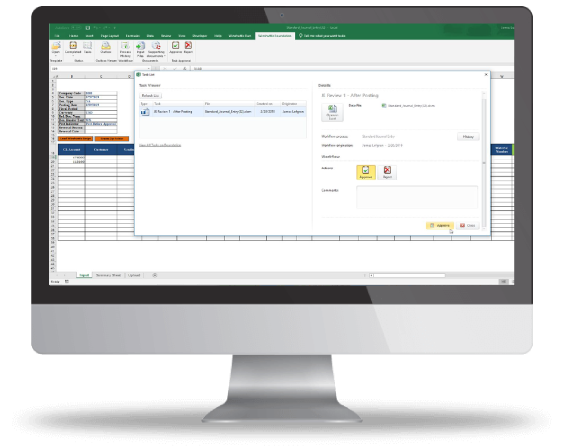eBook
4 Ways SAP® Journal Entry Bottlenecks Affect Your Business and How to Eliminate Them
Getting control of your SAP General Ledger leads to better business results
Companies rely on the financial data in the SAP General Ledger to run their businesses efficiently and effectively. However, as enterprises grow, the number of general ledger journal entries they manage increases exponentially, often making it difficult for a controller or CFO to produce timely and accurate financial reports.
If you’re responsible for your company’s general ledger accounting and associated journal entries, this eBook is for you. In it we will discuss four of the most common journal entry bottlenecks and how Precisely is helping address these challenges.
Discover how each bottleneck affects business results and learn how to regain control of your SAP journal entry processes – without having to undergo a complete digital transformation.
“Fewer than 22% of senior finance executives said they were entirely confident in the accuracy of the data they hold and analyze as part of their role.”
KPMG
Facing Forward – The Evolution of the Modern Finance Leader

Bottleneck 1
Multiple systems of record
Most large enterprises have grown, in some part, through acquisition. As a result, many of you are often left with a mixture of different systems and incompatible instances that make your financial reporting difficult. For instance:
- We have one customer who has over forty (40) different ERP systems that they must report from in order to produce period close financial statements. This is a combination of SAP ECC, Oracle, custom SAP and numerous other systems.
- Other customers have various systems of record that are unable to communicate, so data must be manually extracted to an Excel file and transferred to a headquarters financial organization before being combined and posted to the SAP general ledger for analysis and reporting.

Solution
We deliver solutions that use Automate Studio-enabled Excel workbooks to manage the financial data you extract from multiple, different ERP systems. This gives your business users the ability to correct, test and validate the data before posting to SAP. By focusing on outcomes and allowing your business users to more effectively manage their SAP financial data, Precisely Automate helps customers with multiple systems of record, quickly produce better, more accurate financial reports.
“[When multiple ERP systems are present] General Ledger capabilities frequently suffer… for example, following a merger or acquisition, a company is likely to end up with multiple finance systems. This discord affects the efficiency and effectiveness of the finance organization and makes it difficult to obtain a single view of the enterprise’s financial status.”
Accenture: “SAP New General Ledger”
Bottleneck 2
Data overload
It’s easy to understand how companies with complex business structures become overwhelmed by the volume of SAP journal entries needed to manage financial operations. Exceptions, accruals, corrections, adjustments, and records changes in your business environment can challenge even the most well-run finance organization. For instance:
- Before Precisely Automate, one customer was struggling to handle over 20,000 journal entries within a four-day window to complete their quarterly close.
- Technical restrictions in SAP limiting the number of line items that you can load to a record at one time, create headaches that require documents to be split, or posted in multiple sessions.
- Manual journal entry processes continue to cause many issues for financial teams. We all know that they are slow, expensive and error prone, creating additional challenges to our already inefficient processes.

“Manual processes make it difficult for finance executives to run an efficient and effective operation.”
IOFM
| SAP T-Code | Description | Processing Time Saved |
| FB50 | Enter G/L Account Document | 96% |
| FB01 | Post Document: Header Data | 92% |
| FV50 | Park G/L Account Document | 94% |
| F-02 | Enter G/L Account Posting: Header Data | 93% |
Solution
Precisely Automate has been helping customers overcome the challenges of data overload and manual processes for over 15 years. By allowing your business users to manage SAP data using Excel and automating many of the manual processes required for posting journal entries to SAP, Precisely Automate customers have seen dramatic improvements in their SAP processes and performance. All without having to disrupt your business or implement a complete digital transformation.
“We don’t ever want to go back to our lives before Precisely Automate—especially with how easy it’s made annual statements!”
Corinne Fortin
Administrative and Financial Director Institute Pasteur
Bottleneck 3
Process paralysis
Managing journal entries involves more than simply loading them to SAP. Often, they require complex workflow processes prior to being posted. Reviews and approvals must be secured, strict routing rules followed, and manual tracking to ensure that approved files are posted. Some organizations also have restrictive, legacy workflow systems that no longer function effectively. In other cases, they use email to route Excel files, with manual tracking. As the amount of data grows, and the complexity of business increases, these methods of file management become unsustainable. For example:
- Many legacy workflow systems are limited to single level approvals with very narrow conditions.
- Legacy enterprise systems can be difficult to update when changes in the business environment occur.
- Often simple updates in legacy systems need IT intervention, and with limited resources, require time and careful planning.
- Worst of all, email routing systems require careful manual tracking of approvals and you often use slow, error-prone manual data entry after the file has been approved.
Solution
Precisely Automate delivers journal entry solutions that help you better manage your general ledger without having to change established processes. For instance, we helped one customer transition from an inflexible, single approver legacy workflow solution to a flexible, three-level approval workflow solution which included automatic conditional routing and queuing for auto-posting to SAP. By eliminating the manual secondary tasks such as tracking, email follow-up, and posting, Precisely Automate helped them optimize their journal entry processes, reduce errors, and close the books faster.
“We save around $1.9 Million per year in avoided programming, reduced data entry workload costs and SLA costs. Most importantly, we have given our users a tool that enhances their productivity and the accuracy of the data in our systems.”
Business Process Manager
SAP Center of Excellence Canada Post
Bottleneck 4
Data difficulties
For your company to operate effectively, financial data must be consistently accurate. However, maintaining and improving the quality of your financial data is an ongoing challenge. Simple, innocent mistakes can lead to major problems. And with your CFOs under constant pressure to maintain tighter control over financial data, it is imperative that information be as accurate as possible, otherwise you face significant risks associated with audit failure and restatements. These risks are caused by:
- Manual processes and multiple systems of record that often lead to a significant number of data errors. The resulting poor data quality is among your executives’ top challenges to delivering accurate reporting and forecasting.
- Even with strict procedures and guidelines, we struggle with governance when using email to route Excel files for review and approval. We’ve all had files get lost, duplicated or even loaded into SAP without the proper signoff.
- In the United States, many of us are required to meet SOX (Sarbanes-Oxley) compliance guidelines, but poor process controls often lead to audit failures.
$3 trillion
Yearly cost of bad data in the United States
Thomas C Redmond
Harvard Business Review Sept, 2016
78%
of all businesses cannot forecast their mid-term cash flow within 5% accuracy
Aberdeen Group
Review, approve and track SAP journal entries all from Excel.
Solution
Precisely Automate journal entry solutions are designed to address your data quality, stewardship, and governance challenges. We allow your business users to test and validate data against SAP before it is routed for approval. Once approved, the Excel files can be queued for auto-posting to SAP. In addition, we deliver easy to access logs that allow you to centrally track the review and approval process, lowering the risk of SOX audit failure and improving compliance with internal controls and procedures.
The Precisely Automate enterprise journal entry solution
The Precisely Automate enterprise journal entry solution is intended specifically to help large enterprises like yours, who are struggling with an overwhelming number of journal entries for their SAP general ledger. We help you get control of the processes and improve your ability to manage massive amounts of financial data while simultaneously improving, governance, data quality and employee productivity.
Our enterprise journal entry solution lets users consolidate massive numbers of journal entries into Automate Studio enabled Excel workbooks. The data in the Excel files is easily validated against SAP, prior to being routed for review and approval by the appropriate team members. Automate Evolve manages the workflow process, and everything is tracked and routed appropriately, with files being queued for auto-posting to SAP once all approvals have been received. By automating manual journal entry processes, the enterprise journal entry solution eliminates many of the bottlenecks that hamper SAP general ledger accounting and makes your life easier.
Precisely works with each customer team to understand your current processes, workflows and requirements, and then develops a custom solution that meets your exact needs.
What does the Precisely Automate enterprise journal entry solution deliver?
- Deep integration with SAP for higher reliability
- Scalability to meet the needs of almost any sized enterprise
- Ability to consolidate data from multiple ERP systems in Excel
- Ease of managing SAP data using Excel
- Built-in governance and compliance
- Elimination of most manual data entry processes
- Validation of data against SAP prior to routing, approval and posting
- Flexible, conditional routing rules
- Automatic document splitting and attachment
- Significant reduction in reliance on IT for ongoing support
Effective management of journal entries and general ledger financial data in SAP helps companies like yours achieve better business results. By eliminating bottlenecks and improving processes Precisely Automate journal entry solutions help you better understand your financial status and more effectively manage your enterprise.
What an impact across your entire financial organization
For over 15 years we have helped companies and their financial organizations use Automate Studio enabled Excel workbooks to more effectively manage SAP data. Beyond the SAP General Ledger, we help you manage SAP financial processes and data in accounts payable, accounts receivable, fixed assets and more.
Make an impact across your SAP landscape
Streamline processes and improve data quality in all areas of your business including; master data, supply chain, plant maintenance and operations, HR, and many more with Precisely Automate’s comprehensive SAP data management and process automation platform.
Precisely Automate for financial accounting helps customers:
- Go Faster – Accelerate the speed of financial operations
- Improve Data Quality – Eliminate manual processes and validate data before posting to SAP
- Increase Productivity – Employees manage more SAP data faster working in Excel
- Increase the Impact of SAP – Empower business users to manage SAP data without the need for IT intervention
- Gain Greater Flexibility – By working in Excel, companies have greater workforce flexibility
Using Precisely Automate for managing financial data, customer benefits include:
- Better financial reporting and forecasting
- Lower business risk
- Higher employee satisfaction
- Faster period close



